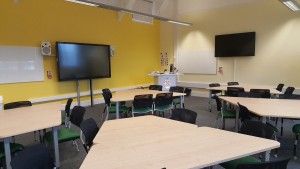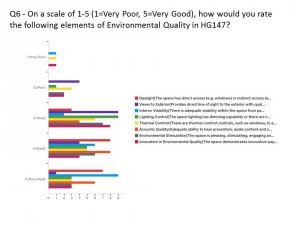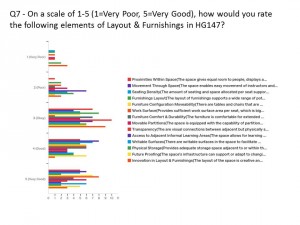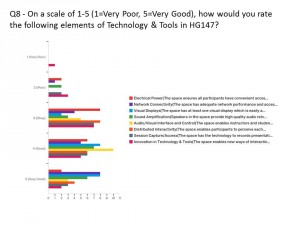 Universities across the UK have recognised the need for investment in both formal and informal learning spaces to support the student experience and this includes the requirement to balance innovative and collaborative spaces with traditional tiered lecture theatres, which are increasingly being adapted to new learning practices and continue to play a useful role in the teaching of large cohorts. We are seeing a move away from desk and chair workspaces to providing a range of types of furnishing and deploying a variety of technologies. We are also seeing a shift in where these facilities are located with the development of more learning hubs and satellites (UCISA, 2016).
Universities across the UK have recognised the need for investment in both formal and informal learning spaces to support the student experience and this includes the requirement to balance innovative and collaborative spaces with traditional tiered lecture theatres, which are increasingly being adapted to new learning practices and continue to play a useful role in the teaching of large cohorts. We are seeing a move away from desk and chair workspaces to providing a range of types of furnishing and deploying a variety of technologies. We are also seeing a shift in where these facilities are located with the development of more learning hubs and satellites (UCISA, 2016).
The Learning Spaces project signals the importance of a cross-professional approach to learning space developments. Such developments, whether new build or refurbishment, are complex projects that tend to happen infrequently and represent a substantial financial investment with a significant lifespan. No one professional group has enough knowledge to make the best decisions alone. It is hoped that professionals from these support services (e.g. ILS, Estates, ADD) to work effectively together and with other stakeholders to deliver outcomes that have a significant transformational effect for the institution.
Assessing learning spaces can inform the creation of new areas to support engaging and productive learning. Involving tutors, assessors and learners in the evaluation and design process ensures that spaces meet the necessary requirements. The Learning Space Rating System (LSRS) project provides a set of measurable criteria for assessing how well the design of classrooms support and enable active learning. The LSRS provides a scoring system to serve as an indicator of how well a classroom’s design serves the goal of active learning.
We used the LSRS as the basis for developing a student survey on their experiences of HG147, which was redesigned as an experimental learning space for 16/17. The survey ran throughout March, in total we received 18 responses, and HG147 scored 110/150 on the adapted LSRS. The responses are represented in the graphs below:
In addition, staff who have taught in HG147 have reflected on their experineces:
“I found that the room was light, comfortable and well equipped with technology. It was also spacious and there was a real sense that students could use the space without getting uncomfortable…The furniture provides good opportunity for reconfiguration within and outside the session.” MD
“…HG147 represents the ideal sort of space for Creative Writing teaching. Our sessions tend to be active and varied in terms of format of delivery, and when we are timetabled in rooms with small desks or fixed rows, this can prove quite challenging to the learning environment we try to establish.” KC
 The project will be reporting back to ELTSEC in June and making recommendations for the adoption of a collaborative cross-professional approach to learning space design, the development of a YSJ learning spaces ‘toolkit’ and/or design standard, wider adoption of the Learning Spaces Rating System, and further Academic staff consultation.
The project will be reporting back to ELTSEC in June and making recommendations for the adoption of a collaborative cross-professional approach to learning space design, the development of a YSJ learning spaces ‘toolkit’ and/or design standard, wider adoption of the Learning Spaces Rating System, and further Academic staff consultation.
Finally, many thanks to all of the students who completed the survey, and congratulations to Danielle who was selected at random and won the Amazon voucher.
What do you think of our existing learning spaces? How would you like to see spaces designed in the future? To what extent do existing learning spaces dictate pedagogic practice, and should it be the other way round? Are our learning spaces accessible and inclusive? Let us know in the comments below…
Phil
Resources
- The UK Higher Education Learning Space Toolkit
- Learning Space Rating System
- FLEXspace – Flexible Learning Environments Exchange
- Learning Space Toolkit
- Evaluating and Designing Learning Spaces


